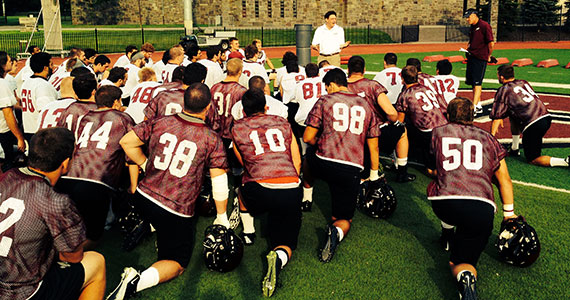
President Jeffrey Herbst speaks to members of the Colgate football team. At right is head coach Dan Hunt.
As more data becomes available about the long-term dangers of sports-related head injuries, Colgate University is implementing a strategy to minimize general contact as well as contact to the head experienced by student-athletes during practice sessions.
The mandatory practice protocol covers all varsity athletic programs, with emphasis on sports where the risk is highest and injuries may be unavoidable — particularly basketball, football, ice hockey, lacrosse, and soccer.
Research on the protocol began last summer, as President Jeffrey Herbst and Director of Athletics Victoria M. Chun ’91, MA’94 sought to take a public stand on student-athletes’ well-being. The result is a collaboration among coaches, administration, and athletic trainers.
According to Chun, the program is unique.
“As we were formulating our concussion strategy we looked for something similar at other universities and colleges and realized that none was to be found,” she said. “We want our current and future student-athletes to know that we are committed to their short-and long-term welfare. At the same time, we don’t feel this will put our teams at a competitive disadvantage.”
Chun, one of the few female athletics directors in NCAA Division I, played volleyball at Colgate and served as head volleyball coach from 1994 to 1997.
Herbst agrees with the policy’s goals. “It would be irresponsible to ignore the data and continue with business as usual,” he said. “Our student-athletes want to win and compete, and they deserve to have us provide the safest environment possible.”
In determining the parameters for the plan, Chun and Colgate’s athletic trainer Steve Chouinard consulted with several coaches and medical professionals, including Dr. Merrill Miller, director of Colgate’s Student Health Services who for the past 30 years has served as team doctor for Colgate athletics.
They also consulted with Dr. Brian Rieger, director of the Concussion Center of Upstate University Hospital in Syracuse, who signed off on the plan. The Athletic Affairs Committee of the Colgate Board of Trustees agreed the university should not only adopt the plan, but also make a strong public statement.
“The brain is wonderfully complex, and there are no replacement parts,” Miller said. “Whatever can be done to reduce injuries is very important. We anticipate that these guidelines will do that, and our student-athletes will greatly benefit.”
Prior to instituting the new protocol, Colgate followed league rules for games, but there was no formalized process for practices.
“We had processes in place to handle head injuries when they occur, but we never formalized a plan to minimize contact in practices,” said Chouinard. “The coaches realized that the one thing we can control is how we practice. If we lessen the contact in practices, then the risk of cumulative injury is reduced. Even if the numbers don’t show we are decreasing the number of concussions, it’s still the right thing to do.”
Lee Woodruff ’82 and Bob Woodruff ’83 have dedicated their lives to creating awareness of the effects of traumatic brain injury, after Bob was struck and nearly killed in 2006 by a roadside bomb while covering the war in Iraq for ABC News. The experience gave rise to the Bob Woodruff Foundation.
“We really do have a chance to be leaders here, in as much as you can prevent head trauma by practicing safely,” said Lee, a member of the Colgate Board of Trustees. “As an alumna and advocate, I’m proud of Colgate for taking real steps, as well as a public stand, on this issue.”
